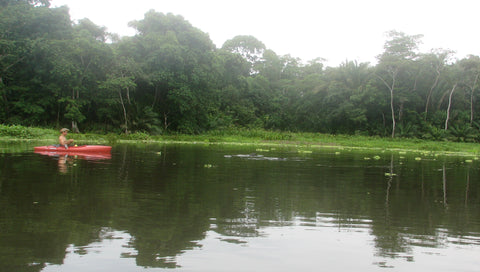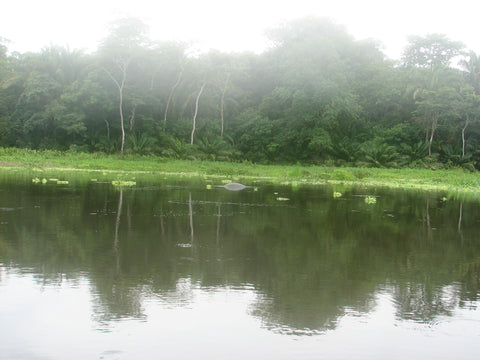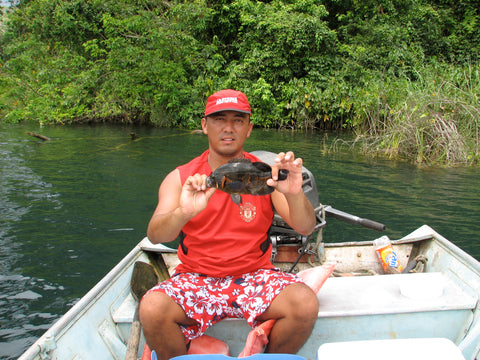I was visiting with family in Gamboa Panama located where the Chagres River joined the Lake Gatun impoundment. Here we are on a jungle Hike with Linda Sanchez. My wife took the picture.

One day we rented a canoe from the local Indian Village and paddled across the Chagres river Into a back creek. We saw a Jesus Christ lizard, they will run across the waters surface at such a startling speed, who knows what you might say. At least it wasn't one of the dozens of snake species, half of which are poisonous.
Ian Sanches is a family friend and knowledgeable local guide for Birding Tourist and also a white water kayaking outfitter. I went kayaking-fishing with him up the remote Chagres river. Fishing wasn't so great but the wilderness scenery was. We found this pod of Manatees feeding in a weedy back bay.


For a couple of weeks I had the use of Ian's red Otter Kayak and access to the the waters around Gamboa. I went up the Chagres river and found a few 14 inch, average sized Peacock Bass and some Oscars. I saw a huge Arowana. One day, a Native fishermen standing upright in a very narrow dugout canoe, was beating the water with the paddle to drive fish into gill nets set along a weed bed.
I went downstream to explore the back bays and channels of Lake Gatun. I saw an amazing variety of jungle and water birds, crocodiles, once a pack of capybaras cavorting on the shore. once they became aware of my stealthy presence, they vanished. The crocodiles were just like Florida alligators, they would sit back at a far distance, watching you with that evil side eye. In a place called Bahia de los Monas, I found a smaller back bay which was blocked off with a boom barrier made of railroad ties strung on a steel cable. These are common and made to keep floating debris out of the Panama Canal. Behind this one was this bay with floating islands. Grass and small saplings were rooted in mats of floating water plants. Here I landed 2 out of 3 above average Peacock bass. The one that got off fought very hard and was certainly bigger than the smaller one.


Further back in the main bay I caught 2 juvenile snook about 14 inches, more slender and darker in color than than our Florida species. Back in a back bay I came upon a narrows. A slight current appeared and then I found myself in a white water situation for bout 8 seconds. A few seconds later white water was rushing the opposite direction. Half a dozen oscillations later it was over. The powerful but gentile wakes of the passing or turning of ocean freighters in Lake Gatun can be magnified in a narrowing passage. Ian told me the locals seek out these places in their kayaks for fun. Not what I was looking for. I did find that when this first started, Peacock bass would go on the feed for minnows caught up in this and I caught a few average sized bass.
Paddling hard to get back home I came around an island. An 8 foot crocodile was up on a beach in a small crescent shaped bay. I was quickly cutting off his escape route and he hit the water at top speed, hydroplaning across the surface with only his whipping tail under the water. He was on course to pass 10 feet ahead of me. He submerged just before crossing ahead of me. I didn't see him until latter, floating 100 yards off giving me that side eye.
I sought out a guide one day at a boat ramp on the Canal. Julio motored us up the canal. We saw a huge Crocodile on the bank. He turned into a side channel leading to a maze of weedy back bays where we caught dozens of mostly small peacock bass. He started off throwing a live minnow out on a hand line of monofilament wrapped around a coke can. Once it became clear I could catch fish on a fly rod, he let me do the fishing while he loaded every one into a 5 gallon bucket to keep and clean later. I kept the 2 largest and and Oscar.


The locals were impressed with fly tackle. It seems like a simple, economical and sensible extension of their popular hand line method. I caught all the fish on Bead Head Estaz-Bunny Leeches, mostly on purple, some on white.